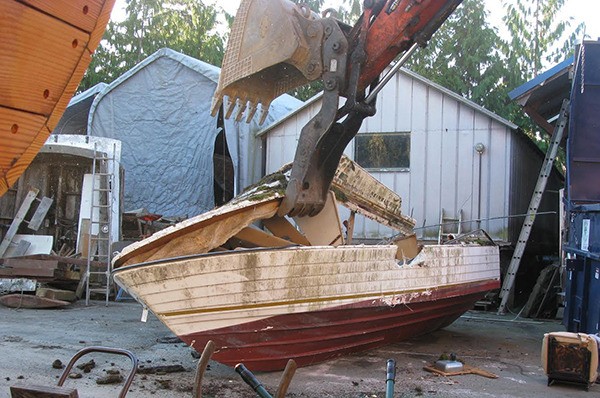Tearing apart a boat that’s past its prime is nothing new for Michael Durland.
In fact, it’s more akin to business as usual at Orcas Island’s Deer Harbor Boatworks, where, over the course of two days, Nov. 13 to 14, Durland and crew demolished five boats whose owners had surrendered various vessels they could no longer maintain or dispose of themselves to the grindstone of the state-funded voluntary turn-in program coordinated by San Juan County’s derelict vessel removal program.
Four made of fiberglass, measuring 21 to 27 feet in length, proved rather routine and crumbled quickly, but even the old-hands at Deer Harbor winced a bit when it came time to gut and disassemble a 38-foot wooden Owens cabin cruiser whose former glory was only faintly eclipsed by the passing of time.
“It’s a shame to have to bust that one up,” Durland said. “It had really good mahogany and some other real nice features on it. We salvaged what we could. But it’s a good thing, the program, because some of these boats would just end up sinking.”
The voluntary “Turn In Option” is a new twist and incentive recently added to Washington state’s 12-year-old derelict vessel removal program. It’s designed to take boats of 45 feet or less, which have fallen into disrepair, off the hands of Washington residents that lack the financial resources to repair and maintain them.
When a 28-foot wooden cabin cruiser was demolished at Friday Harbor’s Jensen’s Shipyard in June, it marked a first for participation by San Juan County in the DVRP turn-in program. Since then, another six boats in the San Juans, the five demolished at Deer Harbor included, have been disposed of under the voluntary program.
With seven boats now to its name, San Juan leads the state’s 39 counties in participation in the voluntary program.
Marc Forlenza, manager of the county DVRP, said the county avoids tapping its own limited DVRP funds by utilizing the state-funded voluntary turn-in program and that mass demolitions, like the one at Deer Harbor Boatworks, which maintains a state-licensed demo facility, also proves more cost-effective for the state Department of Natural Resources. The agency, which manages the DVRP, has been afforded only $200,000 for the voluntary program in its most recent two-year budget.
In addition to boats that have been demolished, Forlenza said that owners of four other “vessels of concern” have removed those boats from local waters at their own expense.
“Working closely with the DNR and [vessel turn-in program] is a win-win situation for the state, county, and the environment,” Forlenza said.
About 33 boat owners have applied, statewide, to the turn-in program since it first debuted in May. A total of 19 boats have been demolished, five are in the demo queue and nine applicants either withdrew or did not qualify. Roughly $135,000 remains in the DNR turn-in program fund, according to DNR’s Tammy Robbins, program manager.
Forlenza notes that not a single derelict vessel has sunk in San Juan County waters in 2014, which overlaps with the emergence of both the turn-in program and an additional DVRP prevention program funded by a People for Puget Sound grant.
“The local derelict vessel prevention portion of the program has proved to be a success and should be continued,” he said. “Unfortunately, funding could end in June of next year when the current grant from [Puget Sound Partnership] expires.”




